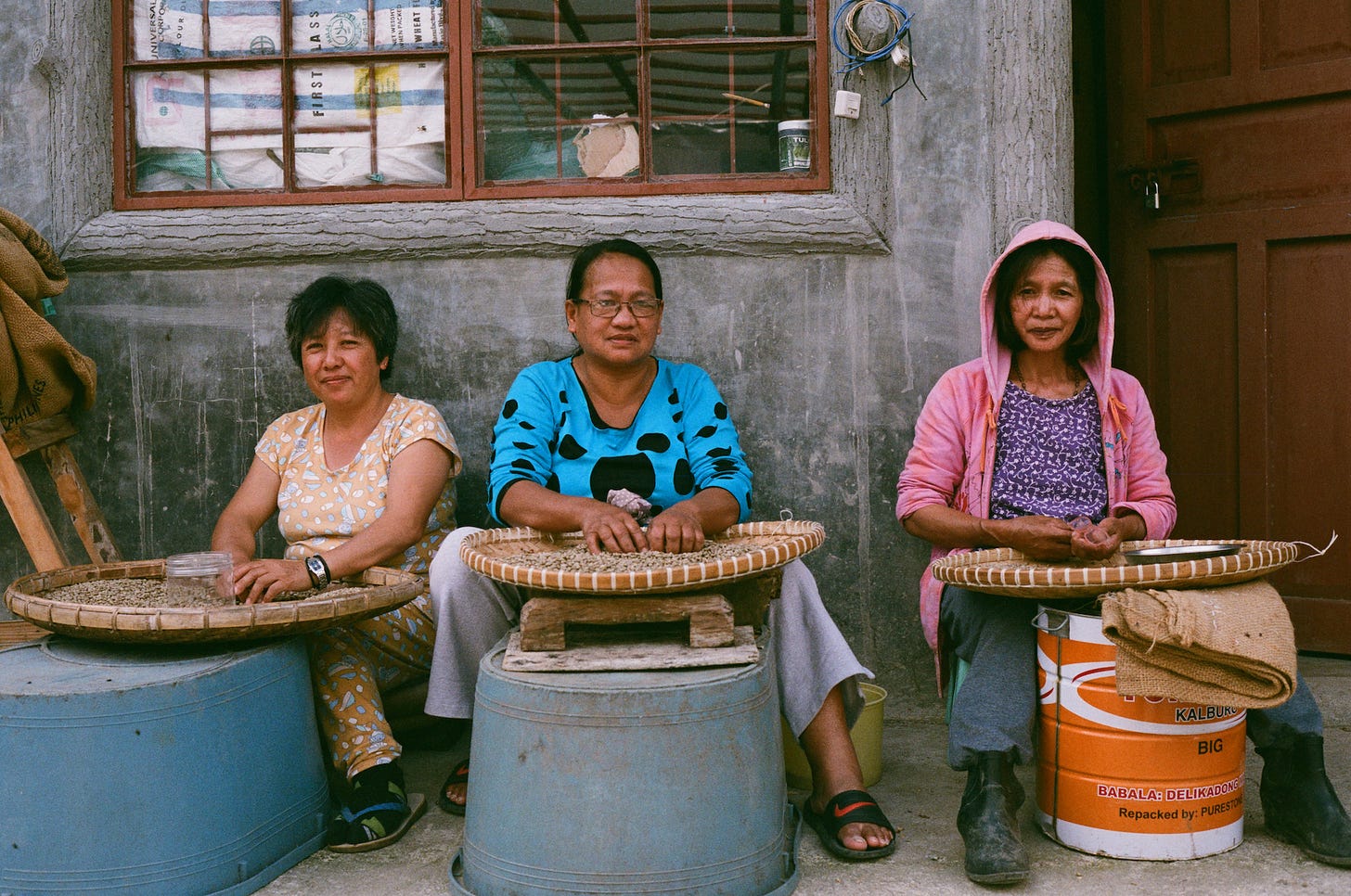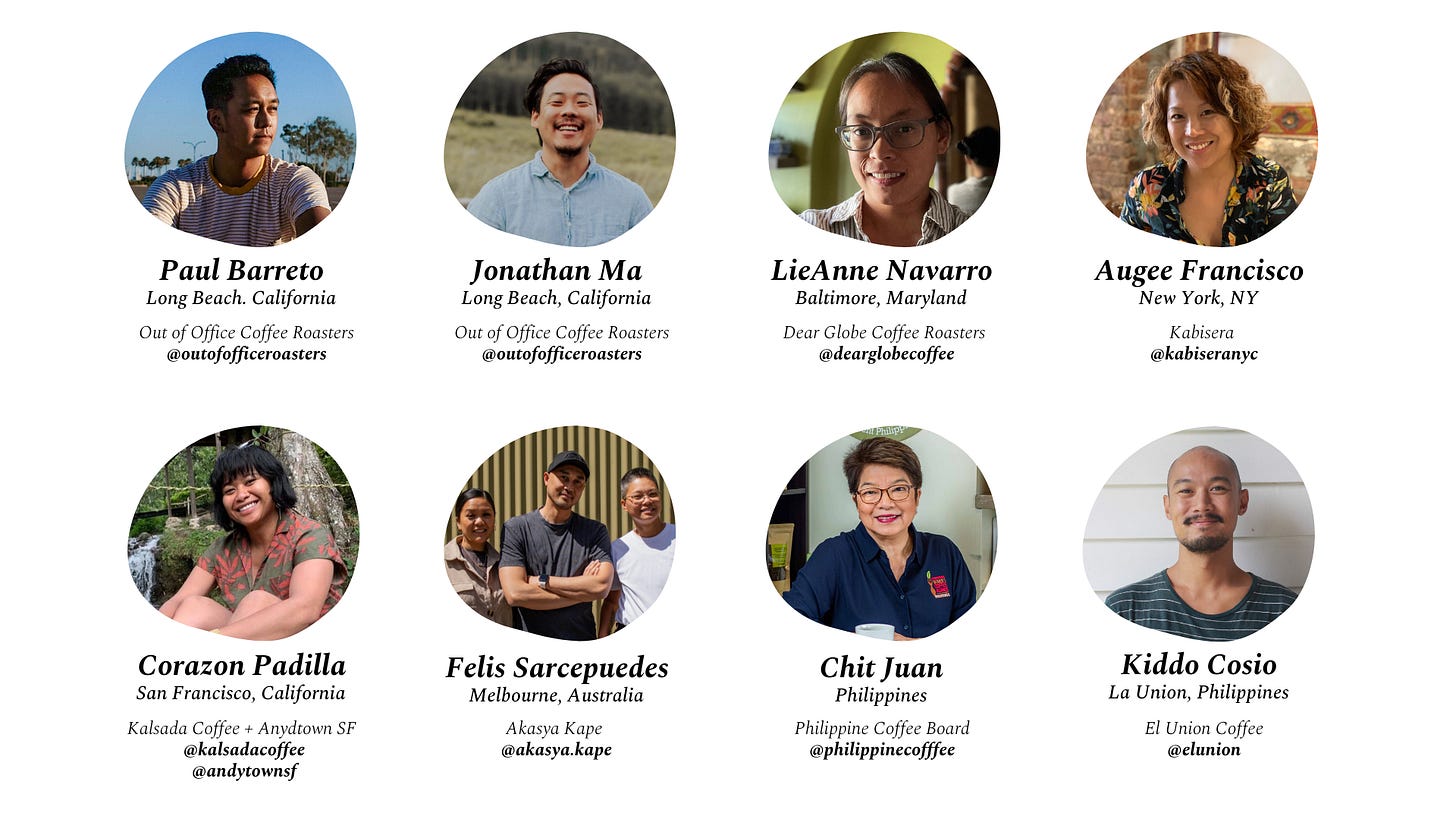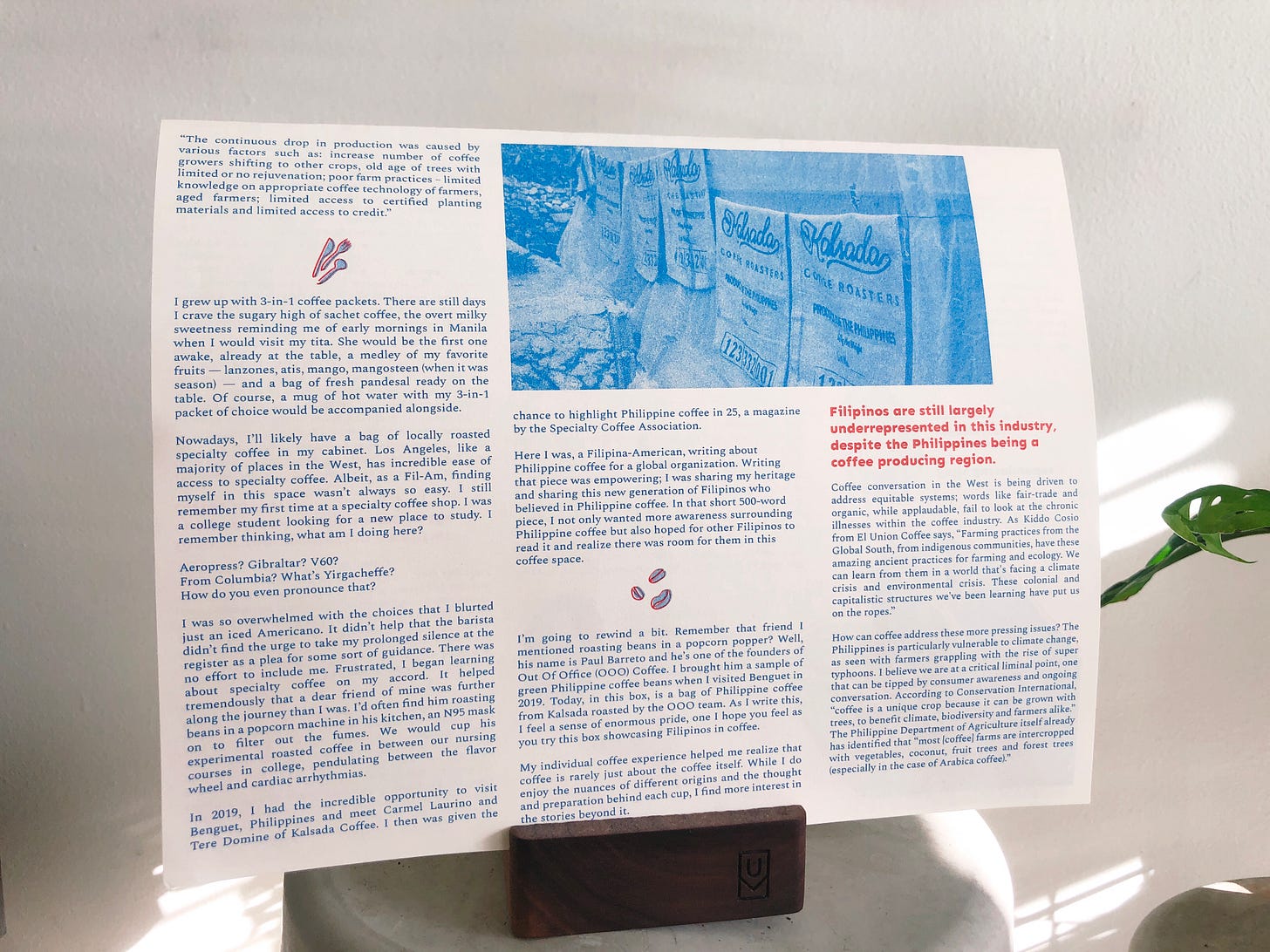Please note that the layout and content of the printed newsletter and this digital issue vary.
Philippine Coffee Beginnings
Like many food origins in the Philippines, the introduction of coffee to the archipelago remains a mystery. The prevailing theory is by way of Mexico during The Manila Galleon trade (which occurred between 1565-1815). In 1740, it is said that two Franciscan friars brought the first coffee tree to Lipa, Batangas where the Macasaet clan successfully managed to propagate and cultivate the first ever Barako (or Liberica variety) tree. Amadeo in Cavite has since earned the title of coffee capital in the Philippines.
Philippine coffee burgeoned in the 1800s. Kapeng barako, known for matapang or strong flavor notes, was synonymous with Philippine coffee and flourished in the Americas (specifically by way of San Francisco) and Europe. Lipa became the 4th largest producer of coffee in the 1880s before the coffee rust fungus proliferated and decimated coffee plantations throughout the country.
Following the invasion, Robusta, a varietal found to be more immune to coffee rust, eclipsed Barako coffee. According to 2019 statistics from the Philippine Department of Agriculture, “The four varieties grown are: Robusta which accounts for 69% of production, Arabica (24%), Excelsa (6%) and Liberica (1%). However, like with the case of ube, the country’s production can hardly meet demand.
“The continuous drop in production was caused by various factors such as: increase number of coffee growers shifting to other crops, old age of trees with limited or no rejuvenation; poor farm practices – limited knowledge on appropriate coffee technology of farmers, aged farmers; limited access to certified planting materials and limited access to credit.”
I grew up with 3-in-1 coffee packets. There are still days I crave the sugary high of sachet coffee, the overt milky sweetness reminding me of early mornings in Manila when I would visit my tita. She would be the first one awake, already at the table, a medley of my favorite fruits — lanzones, atis, mango, mangosteen (when it was season) — and a bag of fresh pandesal ready on the table. Of course, a mug of hot water with my 3-in-1 packet of choice would be accompanied alongside.
Nowadays, I’ll likely have a bag of locally roasted specialty coffee in my cabinet. Los Angeles, like a majority of places in the West, has incredible ease of access to specialty coffee. Albeit, as a Fil-Am, finding myself in this space wasn’t always so easy. I still remember my first time at a specialty coffee shop. I was a college student looking for a new place to study. I remember thinking, what am I doing here?
Aeropress?
Gibraltar?
V60?
From Columbia?
What’s Yirgacheffe? How do you even pronounce that?
I was so overwhelmed with the choices that I blurted just an iced Americano. It didn’t help that the barista didn’t find the urge to take my prolonged silence at the register as a plea for some sort of guidance. Frustrated, I began learning about specialty coffee on my accord. It helped tremendously that a dear friend of mine was further along the journey than I was. He was the only other Filipino I knew at the time really immersed in specialty coffee. I’d often find him roasting beans in a popcorn machine in his kitchen, an N95 mask on to filter out the fumes. We would cup his experimental roasted coffee in between our nursing courses in college, pendulating between the flavor wheel and cardiac arrhythmias.
In 2019, I had the incredible opportunity to visit Benguet, Philippines and meet Carmel Laurino and Tere Domine of Kalsada Coffee. I then was given the chance to highlight Philippine coffee in 25, a magazine by the Specialty Coffee Association. Here I was, a Filipina-American, writing about Philippine coffee for a global organization. Writing that piece was empowering; I was sharing my heritage and sharing this new generation of Filipinos who believed in Philippine coffee. In that short 500-word piece, I not only wanted more awareness surrounding Philippine coffee but also hoped for other Filipinos to read it and realize there was room for them in this coffee space.
Thinking Beyond Origin
My individual coffee experience helped me realize that coffee is rarely just about the coffee itself. While I do enjoy the nuances of different origins and the thought and preparation behind each cup, I find more interest in the stories beyond it.
Filipinos are still largely underrepresented in this industry, despite the Philippines being a coffee producing region.
Coffee conversation in the West is being driven to address equitable systems; words like fair-trade and organic, while applaudable, fail to look at the chronic illnesses within the coffee industry. As Kiddo Cosio from El Union Coffee says,
“Farming practices from the global South, from indigenous communities, have these amazing ancient practices for farming and ecology. We can learn from them in a world that's facing a climate crisis and environmental crisis. These colonial and capitalistic structures we've been learning have put us on the ropes.”
How can coffee address these more pressing issues? The Philippines is particularly vulnerable to climate change, as seen with farmers grappling with the rise of super typhoons. I believe we are at a critical liminal point, one that can be tipped by ongoing engaging conversation. Felis Sarcepuedes of Akasya Kape from Melbourne, Australia is raising consumer awareness surrounding Philippine coffee to empower not only the local Filipino community, but also the Philippine farming community.
“For us, it's just a cup of coffee. For the farmers back home, it’s everything.
If they get hit by a typhoon, it affects them a lot. If they get hit by a volcanic eruption or just anything environmental, it hits them so much. We can get our coffees anywhere but I think just by supporting the farmers back home and empowering them that way, it just makes you feel better as a consumer.”
Coffee, if we allow it, can thrive in diverse ecological systems. According to Conservation International, “coffee is a unique crop because it can be grown with trees, to benefit climate, biodiversity and farmers alike.” The Philippine Department of Agriculture itself already has identified that “most [coffee] farms are intercropped with vegetables, coconut, fruit trees and forest trees (especially in the case of Arabica coffee).”
Is it then possible for an agricultural shift based on this model of sustainability grounded on the concept of ecoculture (defined as the inextricability of nature and culture)? One in which Jonathan London, an assistant professor with a PhD in development sociology, proposes, “the soil is preserved, a wide range of plants and animals are able to live their lives, and humans are able to extract a product that serves multiple needs, including engagement in the market by cultivators.”
The theory sounds logical. Dare I say, fundamental? Why then, is supporting Philippine coffee and Filipinos in coffee so important? Other than the obvious benefit of improving farmer livelihoods, coffee has the potential to put an often omitted praxis into motion. What do I mean by that? Coffee has lived in a dichotomous world with coffee produced mainly in the global South and coffee consumed primarily in the so-called developed nations. Coffee has always served the markets and therefore always been a bottom-line commodity.
What happens when we zoom out from this longstanding economic infrastructure and instead listen to communities that practice outside of this dialogue? We can find ourselves in a richness in how we think about coffee production —one in which abundance spills back into the hands of our communities and the land we use to grow. Kiddo Cosio from El Union Coffee in La Union, Philippines shares:
“Good and quality are very different things. 90+ is quality, right? But good is a different discussion. How much were the laborers paid so that you could achieve that cup score? How much did the farmer get at the end of the day? We have to look out for the lowest common denominator, the least of our brethren. I think the wonderful thing about being in the global South and being in the Philippines is that we really get to explore the goodness that the earth and the goodness that people bring to this story in a way that is so far from consuming countries.”
Greater representation also amplifies voices often overshadowed in the coffee industry. Corazon Padilla of Kalsada Coffee and Andytown Coffee Roasters in San Francisco, California, emphasizes the importance of diversity within the coffee space to provide a more inclusive language.
“When I set the tasting notes for [the Sitio Belis coffee from Kalsada], I chose latik and kalamansi. One, because I wanted to be able to use tasting notes that our farmers or producers can relate to. I also wanted to use it as an opportunity for folks who aren't familiar with those flavor notes [to be] curious enough to look it up and expand their minds and expand their palates.
Part of it, I think, is food diplomacy. What is the best way to learn about another person's culture? Food is a good starting point. That was important when I was tasting these notes. I didn't want to say I taste a lemon or lime in here. With the coconut flavors, I was like, let's be specific. Latik is a very particular flavor. At Andytown, I actually made latik for people. I said this is what it tastes like and use it as a reference point. Everybody was like, how did we not know about this? You don't know about it because it's not part of your cuisine and that's okay.”
Inclusion matters. Not only can more Filipinos see themselves within the coffee space, but also bring with them the fullness of their own unique lived experiences —experiences that can include, but are not limited to: living in coffee origins, in marginalized communities, in systems with deprived access or few allocated resources.
How can voices of resilience and resourcefulness in our spaces refocus coffee conversations? How can our collective experiences change how coffee has long been approached?
Pacita ‘Chit’ Juan of the Philippine Coffee Board has long worked with the Philippine coffee community. While interest in Philippine coffee may be growing globally, she emphasizes coffee’s ability to give farmers ownership, especially in a country crippled by exploitation and in a world driven by the opportunistic hunger of capitalism.
There must be some depth. There must be a real, honest to goodness, genuine relationship. The Philippine Coffee Board, we continue to work with farmers from around the country. We're teaching the farmers how to taste their coffee because before, like in Africa and Latin America, people grew this crop that they didn't know the taste of. Now we're teaching farmers: taste your coffee so you don't send a bad batch. They’re learning to cup and taste. You're empowering them.
With this collection of Filipino voices in coffee, we hope to share how Filipinos are engaging and thinking within their own communities. We encourage you to be open to these shifts in focus. We encourage you to be global citizens, not simply as buyers of these products, but as actual players within the greater coffee discourse. We can have amazing Philippine coffee. We can support the livelihoods of those who grow these coffees. We can also engage with our communities and care for the larger ecosystem as a whole.
“It’s very gratifying when you see how a simple drink like coffee can be a vehicle to help people be their best versions of themselves.” —Chit Juan
Special salamat to:
ICYMI: Get a copy of The Kape Issue in print!
We made printed copies of our Kape Issue in collaboration under TAAS Collaborative only for this month. You can find it in the Kape Project box, which also features Fil-Am makers to celebrate Filipino-American History Month this October. For this Risograph-inked print, we’re excited to work with Risolve, a Pennsylvania-based printing company using sustainable papers, plant-based inks, no chemical drying agents, and low consumable energy Riso machines. Limited quantities available. What does the box include?
— Whole Bean Coffee - 3x bags (4oz each)
Out of Office Coffee in Long Beach, CA / Paul Barreto and Jonathan Ma — Benguet, Philippines
Kabisera in New York, NY / Augee Francisco — Kaulayaw Blend (South America and Africa)
Dear Globe Coffee in Baltimore, MD / LieAnne Navarro — Yirgacheffe, Ethiopia
— We Are SunRaised - 1x “Walang Hiya” sticker
— meryenda - 1x printed newsletter of “The Kape Issue”










